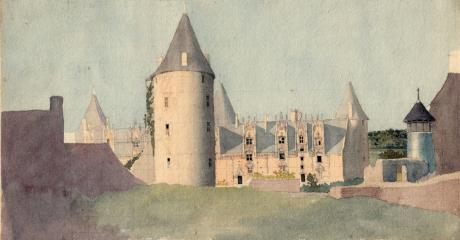Josselin Castle is a medieval castle at Josselin, in the Morbihan department of Brittany, France, first built in the 11th century and rebuilt at various times since. It has been designated as a monument historique since 1928. Guéthénoc, vicomte of Porhoët, Rohan and Guéméné, began to build the first castle on the site around the year 1008, choosing a rocky promontory overlooking the valley of the Oust. The new fortress was named after Guéthénoc's son, Goscelinus. The name is recorded in the Cartulary of Redon Abbey (1080) as castellum et castrum Goscelini, but already by 1108 it was appearing as Castellum Joscelini.
The site chosen for the castle was excellent from both the commercial and the military points of view, and since the 9th century there had also existed an annual pilgrimage in September to the Basilica of Our Lady of the Bramble (Notre-Dame du Roncier), which added greatly to the wealth of the lords and people of Josselin. In 1154, Odo, Viscount of Porhoet, step-father, guardian and regent of the young Conan IV, Duke of Brittany, collected the Breton lords to deprive Conan of his inheritance, but was defeated by Henry II of England, who was also Duke of Anjou, whose protection Conan had sought. Henry married his fourth son, Geoffrey, to Conan's only child, Constance, Duchess of Brittany, and Henry and his son pulled Josselin Castle down in 1168 and 1175.[5] Henry II himself led the demolition and sowed salt into the ruins.
During the Breton War of Succession (1341–1364), the garrison of Josselin fought inconclusively the defenders of the nearby Castle of Ploërmel. To break the impasse, the Battle of the Thirty was arranged, contested by thirty knights from each side, and took place on 26 March 1351 half-way between the two places. The men of Josselin defeated the champions of Ploërmel, who consisted of four Bretons, six Germans, and twenty Englishmen. In 1370 the Breton soldier Olivier de Clisson (1336–1407), later Constable of France, acquired the lordship of Josselin and built an imposing new fortress with eight towers and a keep one hundred yards across.[2] He married his daughter Beatrice to Alain VIII of Rohan, heir to the viscounts of Rohan, whose own castle was not far away. The castle now boasts an equestrian statue of Olivier de Clisson.
In 1488 Francis II, Duke of Brittany, took the castle and partially demolished it. His daughter, Anne of Brittany, restored it to Jean II of Rohan, a great-grandson of Olivier de Clisson, who transformed the property and built a noble new house with a fine granite facade, an early example of Renaissance architecture, importing Italian artists and artisans. In recognition of his patroness Anne, sovereign Duchess of Brittany and Queen Consort of France, Rohan added to the facade at several points the sculpted letter A beneath a cord, her badge.
Banned from Josselin due to their Protestantism, René II, Viscount of Rohan and the other Rohan men could not prevent the Duke of Mercœur, then Governor of Brittany, from turning their castle into a base for the Catholic League in its struggles against Henry IV of France. In 1603, after being advanced by Henry IV to a dukedom, Henry, Duke of Rohan, one of the leaders of the insurgent Huguenots, transferred his military headquarters to his Castle of Pontivy. In 1629, Cardinal Richelieu dismantled the keep and four of the towers at Josselin and announced to Duke Henry: "My lord, into your game of skittles I have just thrown rather a good ball!" In the 18th century, the castle was no longer occupied as a seat of power, and during the years of the French Revolution and the First French Empire it became a prison and warehouse. In 1822, Caroline, Duchess of Berry, persuaded the then Duke of Rohan, Louis François de Rohan-Chabot, to restore it. The Antechamber of the castle contains a marble bust of the 13th Duke, Alain Louis Auguste de Rohan-Chabot, sculpted in 1910 by Auguste Rodin.
The Castle is still a residence of Josselin de Rohan, fourteenth Duke of Rohan, who was President of the region of Brittany from 1998 to 2004
Boys was born at Pentonville, London, on 2 January 1803. He was articled to the engraver George Cooke. When his apprenticeship came to an end he went to Paris where he met and came under the influence of Richard Parkes Bonington, who persuaded him to abandon engraving for painting. Some sources describe him as a pupil of Bonington, although William Callow, who later shared a studio with him in Paris, disputed this.
He exhibited at the Royal Academy for the first time in 1824, and in Paris in 1827. In 1830 he went to Brussels, but returned to England on the outbreak of the revolution there. Paying another visit to Paris, he remained there until 1837, and then returned to England in order to lithograph the works of David Roberts and Clarkson Stanfield.
His most important work, Picturesque Architecture in Paris, Ghent, Antwerp, Rouen, etc., a collection of colour lithographs, appeared in 1839, attracting a great deal of admiration.Drawn on the stone by Boys and printed by Charles Joseph Hullmandel, it was described in a review in the Polytechnic Journal as "the first successful effort in chroma-lithography hitherto brought to perfection". King Louis-Philippe sent the artist a ring in recognition of its merits. He also published Original Views of London as it is, drawn and lithographed by himself, (London, 1843). He drew the illustrations to Blackie's History of England, and etched some plates for John Ruskin's Stones of Venice.
Boys was a member of the Institute of Painters in Water Colours, and of several foreign artistic societies. He died in 1874.

